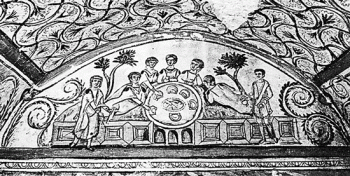American Journal of Archaeology | The Journal of the Archaeological Institute of America
You are here
Changing Places: The Archaeology of the Roman Convivium
October 2010 (114.4)
Changing Places: The Archaeology of the Roman Convivium
Studies of the Roman convivium have traditionally focused on the literary, artistic, and architectural evidence of the event. As such, our understanding of Roman dining is biased toward an elite population that provides the bulk of such information. Missing from the discussion is a materials-based approach whereby the utensils of dining provide information on the mechanics of social meals. Here I present an analysis of 12 Roman table assemblages that identifies patterns of vessel groups to which I apply functional possibilities informed by literary and artistic evidence. The results of the analysis are contextualized using primary literary, artistic, and architectural evidence from which interpretations of dining behavior are offered. Two divergent traditions of dining are identified. One, which I call status dining, confirms the established model of Roman dining, which is centered on individual service so that status boundaries are maintained at the table. The other emphasizes group service through the use of shared vessels, introducing a new style of dining in the Roman world that I call convivial dining. The dining models are placed in their historical and social contexts, and an argument is made for the emergence of convivial dining as a response to a decreasing social identity among the Late Roman sub-elite after the third century and the growth of Christianity in the fourth century.
Changing Places: The Archaeology of the Roman Convivium
By Nicholas F. Hudson
American Journal of Archaeology Vol. 114, No. 4 (October 2010), pp. 663–695
DOI: 10.3764/aja.114.4.663
© 2010 Archaeological Institute of America


